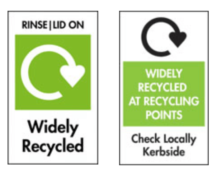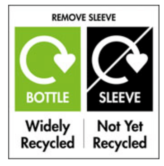A guide to recycling at home
Recycling is difficult there’s no doubt about that. There always seems to be ambiguous information about what can be recycled, how they need to be recycled, what actions we consumers need to take and arguably, whether our recyclables are actually recycled when they leave our homes.
I can’t count the amount of times I’ve checked my home recycling bin and taken out things that can’t be recycled – or the times I’ve found things in the general waste bin that are perfectly recyclable! Not everyone can be a recycling mastermind, I know – which is why we’re here to riddle it out for you.
It may seem straightforward, but it’s not
The trouble is, identifying what is and is not recyclable is only the first challenge.
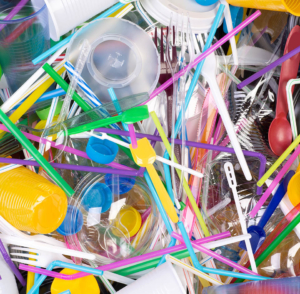
Figuring out how to properly dispose of items that are made from a mixture of materials is confusing – and is actually a big problem with consumerism. Companies need to rethink and strategize their products and packaging to make it as easy as possible for consumers to understand how to dispose of it responsibly – something they rarely do. How can we be expected to do better if the brands we shop with don’t support us on our journey?
Another challenge is that each local authority in the UK does it slightly differently – and I don’t just mean having different coloured bins for different categories of waste. Local authorities have different capabilities and facilities when it comes to waste management. Some have very well-established recycling schemes and streams that can recycle a wide range of materials, whilst others simply don’t have the same resources or level of access, with quite a bit of development to do.
Luckily in general, the UK’s recycling system has come a long way in recent years, and is improving with each passing year.
How does recycling work?
The question that everyone wants to ask, but no one will voice.
In this section we’ll provide some information on how to efficiently recycle, making sure you’re doing everything in your power to ensure the waste your household produces is disposed of properly. We also highlight several tools and services that help make the whole recycling process easier, and clearer to understand as well as guidance on how to recycle in the first place. But firstly, how does recycling work?
The Recycling Chain
- Disposing of waste into the recycling bin, whether public or your own at home.
- Waste collection – again either public or from your home.
- Sorting occurs at Material Recovery Facilities (MRFs), they separate the materials into streams like plastic, metals, glass, paper and cardboard. Once separated they are taken for reprocessing at specialist factories.
- Reprocessing is where the materials are washed and other materials are separated – namely adhesives, labels and other residues. They are then processed into a form that can be reused.
- Recycled – the materials produced from reprocessing are then sold for use in new products and materials.
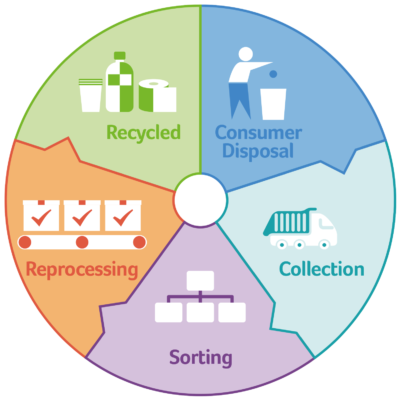

It’s an imperfect system
Lots of materials and plastics are incompatible with one another, and so products you buy, use and recycle may not always make it through this whole process. It depends on the combinations of materials used to manufacture the products you buy (or the packaging they come in). These different materials and combinations can contaminate the recycling streams, which affects the quality of the recycled material being produced.
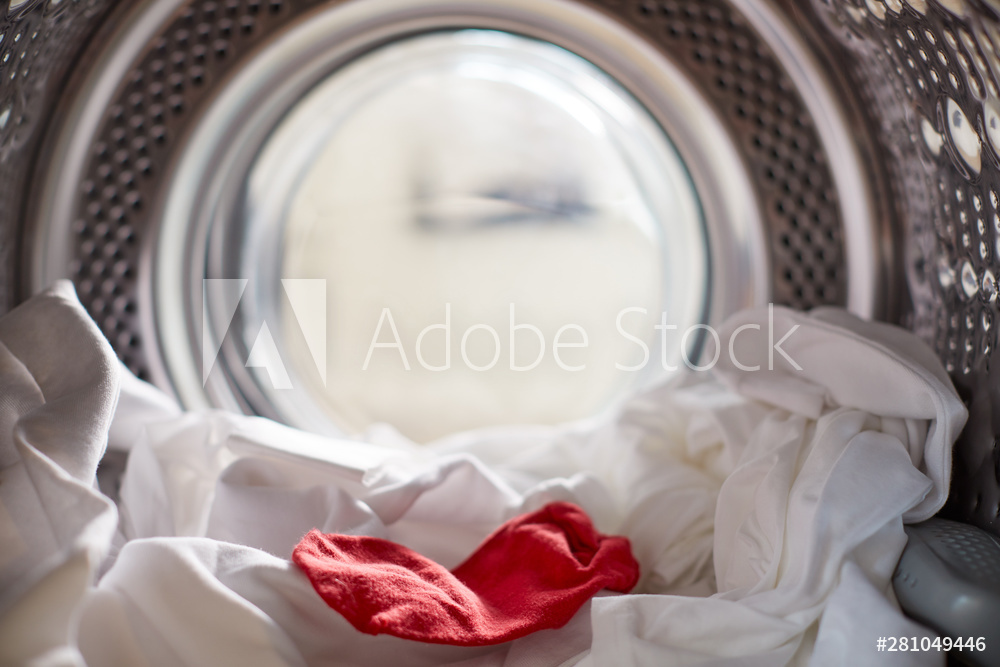
Think of it like loads of laundry.
You know that sinking feeling of dread when you realise you left the red football sock in with the whites load? Disaster, now everything is pink!
It’s a similar concept for recycling, contamination occurs when that “red sock” has snuck into the “white’s” load. The result is a material produced that is of lower quality, or not reusable quality.
These rogue “red socks” increase costs and can damage machinery, as well as contributing to more waste being incinerated or destined for landfill.
Do I need to wash items before recycling?
It’s easy to take for granted just how well-equipped the UK is for recycling. Local councils make it easy for us to place our recyclables in a separate bin to be collected on a regular basis. You take it out once a fortnight (or thereabouts) and boom, you don’t have to worry about it any more – out of sight out of mind.
However, incorrectly recycling something can cause big problems further down the line, and this includes not washing out your recycling properly.
Contamination
We’ve determined a few ways that contamination occurs in the recycling process, but one thing that is consistent across most of the UK is that recyclables need to be washed out.
If a piece of recycling is classed as contaminated, then there’s a risk of the below happening:
- Items are isolated from rest of recyclables which increases processing costs
- Entire recycling load is burnt for energy or sent to landfill
Now it’s highly unlikely that just one piece of unwashed plastic would cause the entire load to be rejected. But, remember our red sock in our very white laundry load?
Good – now, picture everyone in your town putting in one item into their recycling bin, an item that can’t be recycled in your local area. That’s like thousands or red socks in the pink would-be white laundry loads. Yikes.
Don’t the recycling facilities wash the waste before it is processed?
Yes, they do – but have you ever tried to wash last night’s plastic container that has dried sauce all over it? Takes a while, right? These wash cycles at the facilities are designed to fully cleanse before processing, and imagine how hard or costly that would be if no one as washing their recycling? We all have a responsibility to help the process rather than hinder it.
Washing without wasting water
There’s an argument that washing out items destined for the recycling bin would be a waste of water. However, it’s about the bigger picture – do you really want to see tonnes of good recyclables be turned away?
Rinsing out the recyclables in used dishwater won’t waste water.
Common contaminates
The items causing most of the issues in recycling centres are:
- Unwashed food containers
- Used nappies (seriously, don’t put those in recycling bins)
- Clothes and shoes
So, in short – yes you do need to wash or rinse out your recyclables before putting them into recycling.
What can be recycled?
It’s important to know what you can and can’t recycle in your area.
Now, despite the confusion with recycling properly, there are a wide range of items in and around your home that are recyclable at most if not all recycling centres in the UK. These are made from materials that are widely known as being recyclable – glass, cardboard, plastic drinks bottles.
However, there are other things in and around your home that you may have stopped yourself to think, is that recyclable? Well, here’s to helping you figure it out once and for all.
Kitchen recycling
Common recyclable kitchen items
- Washing-up liquid bottles
- Surface cleaner bottles
- Washing detergent and conditioner bottles
- Aerosols of air fresheners or furniture polish – ensure empty and remove plastic caps (recycle with plastics)
- Empty dishwasher tablet boxes and kitchen wrap boxes – flatten to save space in your recycling bin
- Kitchen foil or foil containers – once clean, make sure you crumple into a ball. The bigger the ball the better – but at least the size of an apple, so it can be detected by the machinery.
Common non-recyclable kitchen items
- Cling film
- Crisp packets
- Food and drink pouches that use laminated foil – like pet food pouches, coffee etc.
- Film lids from yoghurts and other similar pots
- Pre-prepared salad bags
- Packaging that doesn’t stay scrunched when you try and scrunch them
Bathroom recycling
Common recyclable bathroom items
- Toothpaste boxes and toilet roll tubes
- Plastic shampoo and conditioner bottles, lids on
- Shower gel containers, lids on
- Liquid soap bottles, remove the pump
- Bleach bottles – empty, (do not rinse) with the lid fastened
- Bathroom cleaners – rinse and replace the trigger spray
- Empty deodorant aerosols and hairspray
Common non-recyclable bathroom items
- Soap dispenser pumps
- Tissues
- Toothpaste tubes (brands are developing recyclable tubes however, be sure to check the packaging)
Electrical items
It’s easy to check if an electrical item, toy or game is recyclable if it reached the end of its working life. Simply ask the following questions:
- Does it have a plug?
- Does it use batteries?
- Does it need charging?
- Does it have a picture of a crossed-out wheelie bin on it?
If the answer is yes to any of these, it is recyclable.
Other household items that are recyclable:
- Magazines, catalogues and newspapers
- Envelopes
- Packaging from online shopping
Recycling do’s and recycling don’ts
Do's
- Make sure all containers, bottles, tubes etc. have been emptied and washed – except for bleach bottles
- Replace lids and tops – if they stay on the container, they will get recycled
- Squash bottles to save space
- Leave on labels, unless the packaging says otherwise – these will be removed in the process
Don'ts
- Don’t put small scraps of unwashed foil in the recycling – wash them, and scrunch them into a ball, larger than an apple
- Leave tape on carboard boxes – this should be removed before the cardboard is recycled (unless it is recyclable tape)
- Don’t recycle glass ovenware, Pyrex, drinking glass or ceramics into your home recycling bin – this will need to be taken to your local facility
- Don’t recycle metal containers for chemicals or paints – check with your local recycling centre for how to recycle these.
Use trusted, online resources when trying to find out how to recycle
The service RecycleNow have a great index of items that can be recycled in the UK and it provides information on organisations that run recycling schemes for many hard-to-recycle materials like tools, white goods, paint and other equipment.
It also details how and where you can recycle other, more common materials through their helpful Recycling Locator tool – you can select what it is you’re trying to recycle from their list, enter in a location and it lists all the locations in your local or chosen area that recycles the materials you’ve selected.
Alternative recycling services
Another way to recycle difficult or unrecyclable materials is through a service called Terracycle. Terracycle run funded programmes that support and recycle common hard-to-recycle items like cosmetics, beauty waste, plastic packaging, pet food pouches, kitchen utensils, beverage capsules, eye wear, jewellery, shoes, pet toys, dining disposables and party supplies and even used gum and cigarette butts.
They offer Zero Waste Boxes for homes to buy, fill and send off to be recycled, but they also offer recycling programmes that allow members of the community, or local businesses and service providers to become members and set up “drop-off” locations for specific types or brands of products that Terracycle work with. Companies sponsor the recycling programme, and then across the UK people can sign up to join a recycling programme and become a drop-off location discoverable in the Terracycle location map and set opening hours.
For every full box sent back to Terracycle, they credit you with points. These points can be used and exchanged for donations to schools, charities, and other non-profit organisations of your choosing.
To find out more, simply enter your location on their homepage and you’ll be able to see a list of local programmes, and drop-off locations, or sign up to a specific programme.
Recycling symbols explained
Probably the most common misconception when it comes to recycling is understanding what all the different symbols on the label mean, and what symbol means an item is recyclable. Often companies draw upon this confusion, and don’t make it any easier to dispose of their product – sometimes I’ve been faced with a label that doesn’t have any information at all on it about how to recycle the product or packaging I purchased. Frustrating, right?
I’m sure we’ve all been faced with this choice: do you risk contaminating the recycling with a potentially non-recyclable product or give up and just put it in general waste to go to landfill – saving yourself the hassle?
Companies must get better at informing consumers how to recycle their products and packaging. The entire lifecycle of a product and it’s packaging should be considered in the manufacturing, and the charity WRAP works with businesses, governments, and communities to support and promote this sustainable waste management. They say:
“The primary role of packaging is to protect the product and help eliminate product waste. This is paramount, since the carbon impact of the product generally far outweighs that of the packaging. However, wherever possible, packaging should be designed in a way that minimises environmental impact, uses the minimum amount of resources possible, and is recyclable.”
With that in mind, let’s do some myth busting, and break down exactly what these waste logos and labels on our household products mean. Below are common on-pack recycling labels (OPRL), and what they mean.
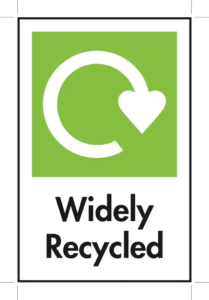
|
The Widely Recycled symbol applies to packaging that is collected by 75% of Local Authorities across the UK. You’ll often find this symbol on plastic bottles, containers and so on. You may also see variations such as these, that give further instruction on how to recycle the packaging. |
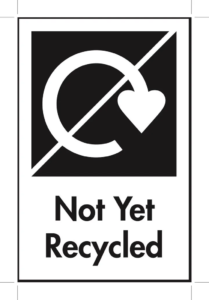
|
The Not Yet Recycled symbol is pretty self explanatory. You may find this more often on packaging and products that use multiple materials – like microwave meals, or some plastic bottles. You may see combinations of the Widely Recycled and Not Yet Recycled symbols, that indicate how to throw away the packaging. |
 |
The Green Dot is commonly mistaken as a symbol that means the packaging is recyclable. This is not true! The Green Dot is used in European countries and indicates that the producer has contributed towards the recovery and recycling of packaging. |
 |
The Mobius Loop indicates that item is capable of being recycled. Sometimes this symbol may have a percentage in the centre – this simply means that item is made from a percentage of recycled material. |
 |
Plastic resin codes are used to identify the type of plastic used to make the item, from 1 to 7. PET is a common polymer used to make plastic objects and packaging. |
 |
This symbol is from Keep Britain Tidy, and simply encourages you not to litter. |
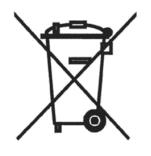 |
This symbol is normally used on electrical items, and merely indicates you should not put this in general waste. Items like these should be taken to your local recycling facility. |
 |
This symbol means that the item needs to be recycled in a glass bottle bank – don’t forget to separate colours. |
 |
This symbol means that the item or product is certified to be industrially composted. Compostable plastics cannot go in your home recycling bin, as it will contaminate waste streams. Some Local Authorities have the capability to accept these kinds of plastics, either through your garden waste or at your local facility.Please check to see if your Local Authority can accept these plastics – if not, these must go in your general waste. |
 |
This symbol means that the product is suitable for home composting. |
 |
This symbol means the item is made from recyclable aluminium. |
 |
This symbol means the item is made of steel. All Local Authorities collect steel cans for recycling, bit other steel and metal items can be taken to your local recycling facility. |
 |
This is the Forest Stewardship Council (FSC) logo, which means the paper, card, or wood in the item has been sourced from well-managed forests. |
Alternative plastics – biodegradable and compostable
In the wake of the “war on plastics”, more and more companies are shifting towards what’s known as ‘bioplastics’ for the manufacturing of their products and packaging.
Picture this: You’re enjoying some fruit from your office canteen when you notice something about the plastic pot it came in; printed on the side was “100% compostable plastic”.
Once you’ve finished with the pot and are ready to dispose of it, you’re faced with a dilemma.
What bin do you put it in? The recycling, or general waste bin? You don’t have a compost heap at home, but if you did, would it be better to take it home and compost it there?
The answer is: none of the above.
What are bioplastics?
Bioplastics or bio-based plastics as they are sometimes called are simply plastics made from plant or other biological material instead of petroleum, often referred to as biomass. They are made of natural polymers from agricultural, cellulose or potato and corn starch waste. To be considered a bioplastic, the material must be made from at least 20% renewable resources, like PLA.
Bioplastics can either be partly, or made entirely from biomass, and they are not the same as biodegradable or compostable plastics. These bioplastics can be biodegradable but not compostable, or biodegradable and compostable. Some that are made from biomass that cannot easily be broken down by microorganisms are considered non-biodegradable.
What is the difference between degradable, biodegradable and compostable?
The terminology used for these kinds of plastics varies a great deal, and it’s difficult to truly understand what each means. In researching for this section, I struggled to find multiple definitions that supported each other, let alone agreed on what the terms actually meant. Here are some explanations into what each of the terms mean.
Compostable
Compostable plastics are made out of materials that have been certified of being “capable of breaking down into carbon dioxide, water and biomass” at the same rate as other organic materials like cellulose would in a compost pile, without leaving any microplastics, chemical or toxic residue behind. They will not harm the environment.
They tend to be made out of polylactic acid (PLA), derived from corn starch or sugar cane, and essentially become nutrient-rich fertiliser for plant life once fully composted. There are 2 types of compostable plastics – those that are suitable for home composting, and those that can only be composted at an industrial facility.
Compostable is not to be confused with biodegradable though; the terms may be used interchangeably, but they are certainly not the same thing.
Biodegradable
Biodegradable means that the material will eventually break down into smaller and smaller pieces by a natural process – they do so over an undetermined length of time and may leave behind toxic residues and microplastics.
Biodegradable plastic can be completely broken down into compost, carbon dioxide and water by microorganisms under the right conditions – similar to process for compostable plastics. The term itself, “Biodegradable”, tends to be used when decomposition happens in weeks to months, though it can be up to several years. Bioplastics that don’t biodegrade that quickly are called “durable”.
Degradable
All plastic, even traditional plastic, is degradable. However, just because it can be broken down into tiny scraps, powders or pieces doesn’t mean the materials will ever return to nature. Some agents or additives are designed to be combined with traditional plastics to make them degrade more quickly. Some examples are:
- Photodegradable plastic breaks down more readily in sunlight
- Oxo-degradable plastic disintegrates more quickly when exposed to heat and light
Some of these agents don’t leave any microplastics, chemicals or toxic residues once the plastic has been broken down – but some can and do.
It’s important to find out whether your Local Authority has the facilities to recycle these different types of plastic, because if disposed of in your normal recycling bin they can cause major problems and incur unexpected costs throughout the recycling chain.
The problem with these plastics
These alternatives are flooding the market, swiftly making their way into our hands, and unfortunately, waste bins. Businesses are moving away from single use plastics, in favour of these “eco-friendly” plastics, in a bid to “be green” without compromising on convenience.
The problem is, consumers are more often than not misled by unsubstantiated “green” marketing claims these companies make, and as such are not educated how to dispose of these products correctly.
Compostable plastics are designed to break down in specific conditions in an industrial composting environment. They need a specific combination of heat, light, and water in order to decompose properly; conditions that a home-run composting heap just can’t meet the needs of. The same can be said for other bioplastics – they must be recycled in a separate recycling stream to your run-of-the-mill petroleum-based plastics.
What’s more, these facilities are scarce – in the UK, there are 170 of these plants capable of recycling the material at the time of writing. In the US, this rises to only 185 confirmed facilities. If consumers dispose of these bioplastics improperly, like in my case either in the general waste bin or the recycling bin, it creates an entirely new waste problem.
In a landfill, there isn’t the right environmental controls for them to degrade or decompose. On the other hand, recycling plants can’t process PLA with their PET plastic counterpart; they’re as compatible as oil is in water. Separating them and sending them to the correct facility for processing is costly, in both time and money.
Until there are more facilities and better infrastructure to deal with recycling these plastics properly, they will remain a problem.
What this means for your home
Bioplastic alternatives pose as much of a threat to the environment, if not more so, than traditional, petroleum-based plastics.
The three R’s, Reduce, Reuse, Recycle are everywhere. Despite innovative solutions, and great steps forward in the recycling industry, it’s becoming clearer that as the truth about the climate crisis spreads the third R cannot always be relied upon. Everyone must move away from consuming disposables, only using them where necessary.
Considering the journeys of the products and packaging that comes into your home is key – and whilst businesses and organisations are being called upon to take responsibility for the entire lifecycle of their products and packaging, it’s down to all of us to be conscious of our waste.
One way we could combat this is avoid compostable plastic packaging altogether, until you’re sure your local authority has the infrastructure in place to deal with that waste. Read our Guide to Better Waste Management for recommendations on how to minimise your household waste.
Get unlimited access to our exclusive content, including this & many other of our guides by joining the SaveMoneyCutCarbon Club
The benefits of our ClubAlready a member?
